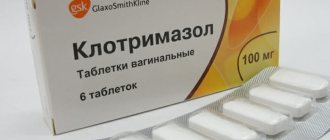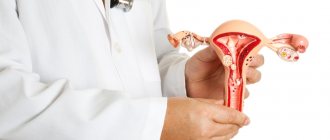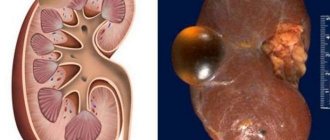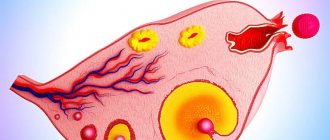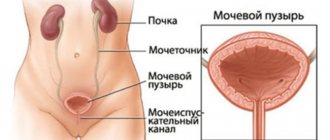Category: Symptoms of thrush - section of the website molochnicamy.ru Published 01/23/2019 · Comments: · Reading time: 7 min · Views: Post Views: 19,522
Thrush, or candidiasis, is a common disease of the female genitourinary system. Men suffer from this infection less often, but often become carriers of the disease themselves. The causative agent of the disease is a fungus of the genus Candida, which is part of the vaginal microflora and normally does not cause pathological changes.
Unpleasant symptoms indicating the onset of an infectious process appear when Candida begins to multiply rapidly, negatively affecting the genital mucosa. Discharge from thrush in women is one of the main signs that indicate the occurrence of the disease.
What is candidiasis, features of the disease
Genital candidiasis is considered one of the most common gynecological ailments: according to medical statistics, about 75% of the fairer sex have experienced its manifestations during the reproductive period at least once in their lives.
The causative agent of genital candidiasis or thrush is fungi of the genus Candida - yeast-like microorganisms that are normally part of the natural microflora of the epithelial tissues of the female genital organs. The development of the disease occurs as a result of the accelerated reproduction of these fungi and their disruption of the normal, natural balance of the environment of the reproductive tract.
https://youtu.be/bqJ9m-Sdpyk
What does thrush look like in women?
first signs of thrush in women should make you worry about your health (see photo 2). At first it is itching, hyperemia, burning of the genitals, and acute pain appears when urinating. It is somewhat less common to observe similar signs of thrush in men, which is due to an anatomical feature.
The first signs are not always expressed by the appearance of discharge - they may appear later. Typically, thrush in women appears shortly before menstruation. During this period, the organs become the most sensitive and vulnerable.
Symptoms in girls are much more pronounced in warm weather. These are baths, saunas, steam baths, solariums, beaches. Symptoms of thrush in women (photo in gal.) are the earliest, and can be caused by ordinary tampaxes if hygiene is poor. Not every woman knows what the signs of the disease are and often skips the initial stage, attributing everything to a simple lack of hygiene. Meanwhile, this disease is quite serious.
White curdled discharge and itching
Abundant curdled discharge caused by fungal microflora is often white. Sometimes they are the only symptom of the disease, but more often they are accompanied by other unpleasant subjective symptoms.
Why does the small fungal microflora that lives on the mucous membranes suddenly begin to multiply intensively and provoke an inflammatory process?
If candidal inflammation occurs against the background of significant depletion of immune defense mechanisms, the mucous membranes are not able to retain the pathogen on the surface for a long time, and after a period of acute inflammation, Candida “hides” in the deeper layers of the vaginal epithelium.
Usually, it takes no more than two months for the formation of a full-fledged chronic process. Vivid symptoms of the acute stage give way to mild chronic inflammation, which is characterized by long remissions and asymptomatic periods of exacerbation.
A chronic inflammatory process caused by a fungal infection can last for years, and it is extremely difficult to cure such inflammation.
During an exacerbation of candidal inflammation, patients often experience a cheesy discharge without any subjective sensations - itching, pain, discomfort and burning. Sometimes leucorrhoea does not have a cheesy structure, it is simply white or similar to “normal”, mucous.
Chronic inflammation is characterized by mild hyperemia of the vaginal mucosa, the absence or a small amount of grayish deposits, and local atrophic changes. Upon examination, changes are visualized not only in the vagina; the infection often affects the vulva and urethra.
The presence of a chronic fungal infection in the vaginal mucosa aggravates the local dysbiotic process and creates conditions for excessive proliferation of secondary pathogenic microflora. As a result, a sluggish fungal infection can transform into a purulent inflammation of the vaginal mucosa caused by a microbial association.
Therefore, candidal infection can be confused with another pathology, and sometimes it masks it.
White cheesy discharge, odorless or with a weak sour odor, the smell of dairy products with itching and redness of the genitals may indicate candidiasis. Thrush is a fungal disease that affects the epithelial tissue of the genital organs. According to statistics, 75% of women have experienced this disease.
Acute inflammatory processes caused by the development of a fungal infection are not always accompanied by a persistent unpleasant odor. Rejected curd-like mucous inclusions, which begin to smell sharply when they come into contact with underwear, are a symptom of an already intensively developing pathological process.
The disease at an early stage is not burdened by the presence of an unpleasant odor. In secret, only sour notes can be “heard”. Experts advise starting treatment at this stage, but strongly discourage the use of folk remedies.
Classification and symptoms
Symptoms of thrush largely depend on the ability of the female body to resist infection. The severity of itching and burning depends on the nature of the dysbiotic disorders.
Thrush initially develops on the surface of the mucosa, where conditionally pathogenic microorganisms are located. A decrease in the number of lactobacilli leads to the proliferation of both Candida fungi and other pathogens of opportunistic flora. Often, fungi enter into microbial associations and together participate in the development of inflammation. For example, in 20% of cases, candidiasis is combined with trichomoniasis and gardnerellosis. However, the development of exclusively candidiasis cannot be ruled out.
The development of candidiasis is influenced by the number of lactobacilli.
Carriage
If vaginal vaginosis is not intense, the remaining lactobacilli inhibit the growth of Candida fungi. Lactic acid bacteria prevent infection from penetrating into deeper layers. However, complete destruction of Candida fungi does not occur. In this case, the fungal population is in equilibrium with lactobacilli. If candidiasis persists long enough, and the number of lactobacilli is dominant, symptoms of candidiasis do not develop. In this situation we talk about the carrier stage.
If dysbiosis is eliminated using the reserves of the female body, the required amount of lactic acid bacteria is restored. This scenario is only possible if the immune system is adequately functioning. Thus, the woman recovers.
Acute form
The acute course of candidiasis is bright and can occur after taking antibacterial drugs, stress, or inflammation in the vagina. The woman is bothered by cheesy discharge, itching and burning sensation. The acute form of thrush progresses over two months. In the absence of adequate treatment, the acute course becomes chronic.
Chronic stage
Candidiasis can persist for quite a long time, and then the defense mechanisms become thinner, which leads to an episode of exacerbation. During an exacerbation, a woman is bothered by discharge, burning and itching. Then remission is observed. As a rule, such recurrent thrush occurs against the background of gynecological and extragenital diseases. During remission, there is no cheesy discharge, itching or burning.
Symptoms of candidiasis can vary. Manifestations depend on whether Candida fungi enter into microbial associations. However, thrush can be recognized by its characteristic symptoms.
- Itching. The itching sensation intensifies in the evening and at night. The intensity of itching increases during intimacy, physical activity, and hygiene procedures. Itching may also be more severe before menstruation.
- Burning. Usually itching is accompanied by a burning sensation, which is associated with the reaction of the vaginal mucosa to local inflammation. Typically, itching and burning are the first signs indicating a fungal infection.
- Curdled discharge. It is by the discharge, which has a specific consistency, that one can suspect the development of candidiasis. The curdled discharge may be copious and have the smell of sour milk. There may be yellow stains on your underwear. If the infection is of a combined nature, the appearance of the discharge may differ.
- Urinary disorders. During the acute phase, burning and stinging occurs during urination.
- Rash on the skin of the external genitalia. Often, upon examination, a small rash in the form of blisters is detected. These rashes are often accompanied by itching and lead to scratching and increased discomfort.
Causes
The main reasons that influence the development of this disease are:
- Excessive and prolonged use of antibiotics
- Reduced immunity
- Hormonal disorders
- Use of birth control pills, especially for women
- Constant douching
- Excess weight
- Poor quality linen.
Most often, itching and curdled discharge (to be precise - curdled, since in appearance they resemble cottage cheese) are associated with vaginal candidiasis (thrush). In addition to the characteristic leucorrhoea and itching, which intensifies in the evening, after physical exertion or during menstruation, redness and swelling of the genital organs and discomfort during sexual intercourse are also observed.
But even if you find all these signs in yourself, do not rush to make a diagnosis yourself, because other diseases can exhibit similar symptoms, for example:
Only a doctor can reliably determine the presence of thrush or one of the listed diseases based on the patient’s complaints and using a microscopic examination or cultural diagnosis of a smear.
Diseases accompanied by curdled discharge and itching often occur during promiscuous sexual intercourse; frequent changes of partners greatly increase the risk of infection of the genitourinary system in women.
In addition to genital candidiasis, gynecological diseases such as ureaplasmosis, mycoplasmosis and chlamydia can cause the appearance of cloudy-white, cheesy vaginal discharge in women. The causative agents of these diseases are the smallest pathogenic organisms - mycoplasma and chlamydia.
As a rule, vaginal discharge in women suffering from these diseases has a dark-gray tint and a strong, foul odor.
Regardless of what was the main reason for the appearance of unnatural vaginal discharge in a woman, her discovery of white vaginal discharge with a cheesy consistency is an absolute reason to immediately seek professional medical help from a gynecologist.
Waiting tactics and all attempts to get rid of gynecological diseases on your own often only aggravate the course of the disease and significantly complicate the process of subsequent treatment.
The causes of leucorrhoea are different. But mostly women worry about odorless leucorrhoea: curdled discharge and itching, what does this mean? This is candidiasis or thrush, a very common disease among women. This disease is dangerous for a sexual partner.
Symptoms of candidiasis are: irritation, burning, severe itching. In small quantities, the Candida fungus is necessary for the body for the mucous membrane of the gender organs. However, there are factors that provoke increased development of the fungus.
Reasons that increase the growth of fungus include:
- hypothermia;
- blood sugar;
- stress and nervous tension;
- wearing underwear made of poor quality material;
- use of antibiotics and hormone-containing drugs.
There is a white, curd-like discharge with itching and no odor. The color may be yellow or green and depends on the bacteria that caused the inflammation.
Other reasons
Curdled leucorrhoea can accompany not only candidiasis. Other causes of discharge: chlamydia bacteria, mycoplasma infections, sexually transmitted diseases. These diseases are associated with curdled gray leucorrhoea, itching and pain.
The presence of vaginal discharge in women is as physiological as, say, the formation of tears, saliva or gastric juice. Their number and character are strictly individual and depend mainly on the phase of the menstrual cycle.
However, the appearance of such unpleasant symptoms as itching, pain, discomfort, along with pathological discharge, which also includes cheesy discharge, may indicate a number of diseases.
Most often, itching and curdled discharge (to be precise - curdled, since in appearance they resemble cottage cheese) are associated with vaginal (thrush). In addition to the characteristic leucorrhoea and itching, which intensifies in the evening, after physical exertion or during menstruation, redness and swelling of the genital organs and discomfort during sexual intercourse are also observed.
But even if you find all these signs in yourself, do not rush to make a diagnosis yourself, because other diseases can exhibit similar symptoms, for example:
Only a doctor can reliably determine the presence of thrush or one of the listed diseases based on the patient’s complaints and using a microscopic examination or cultural diagnosis of a smear.
Diseases accompanied by curdled discharge and itching often occur during promiscuous sexual intercourse; frequent changes of partners greatly increase the risk of infection of the genitourinary system in women.
Standard options
The appearance of discharge in the fair sex is a normal reaction of the body.
The physiological fluid produced by the genitals can be put on a par with such phenomena as the formation of gastric juice, saliva and other natural secretions. Discharges play an important role for the normal functioning of the female body. They clean the genital tract and prevent various infections from entering. The characteristics of vaginal fluid will be individual for each woman, because they depend on the age, degree of involvement in sexual activity, hormonal levels and a number of other factors of the carrier. However, the normal parameters that apply to all patients include:
- Restrained abundance of discharge;
- Watery and slimy consistency;
- A slightly noticeable sour odor or absence of it as such;
- Colorlessness or slight yellowish/whitish tint;
To determine the degree of vaginal cleanliness, a special system was created, according to which:
- The 1st degree of purity is characterized by the production of a thin secretion of transparent consistency, which contains a significant content of beneficial protective microorganisms - vaginal bacilli. They produce lactic acid from the epithelial cells of the vaginal mucosa, which prevents the spread of pathogenic bacteria in the genitals;
- The 2nd degree of purity is distinguished by thick secretions of a characteristic whitish hue. Microscopic examination of the discharge makes it possible to detect not only vaginal bacilli, but also other non-infectious microorganisms. Such discharge is also a natural reaction of the body. The development of microbes is usually provoked by violent sexual intercourse or self-medication at home;
- The 3rd degree of purity detects an excessive content of leukocytes in the smear. Vaginal secretion has an alkaline reaction, in which the presence of streptococci, staphylococci, E. coli, and sometimes Trichomonas is noted;
- The 4th degree of purity is characterized by the complete absence of lactic acid microorganisms. The leukocyte count turns out to be critically exceeded, and the presence of pathogenic microflora is established. The vaginal environment is alkaline.
If the discharge is characterized by a specific consistency, strange color and sour stench, all this indicates the 3rd and 4th degree of vaginal purity. The liquid, which is not a normal variant, has a cheesy appearance and is usually accompanied by associated symptoms such as itching, skin irritation, hyperemia and severe discomfort.
Treatment of itching and curdled discharge due to thrush
In case of acute candidiasis, detected for the first time, local treatment with imidazole-based suppositories and ointments (Clotrimazole, Candide, Candibene, Canesten) is widely practiced. They successfully neutralize the fungus, but therapy with their help is carried out for at least 7 days. In this case, the drug in the form of suppositories often leaks from the vagina, which causes some inconvenience. But an unfinished course of treatment often causes the disease to recur again and again.
An alternative to such drugs is the bioadhesive Ginofort cream, which is injected deep into the vagina using a special applicator. Thanks to the special structure, which ensures the gradual release of the active substance (butoconazole), it is enough to administer 5 g of cream once. After just one application, butoconazole is released on the vaginal mucosa for another 5 days.
For mild to moderate disease, monodose therapy with fluconazole-based drugs is used: Fluconazole 150 mg, Fucis, Diflucan, Mikosist and others. They are equally suitable for both men and women. Do not forget that thrush must be treated in both sexual partners at once. Taking Fluconazole 150 mg is also recommended once before and after antibiotic therapy to prevent thrush.
In 90% of cases, thrush is caused by Candida albicans, but sometimes Candida glabrata is the cause of the disease. In this case, treatment is carried out with Amphotericin suppositories. Pregnant women are mainly prescribed Pimafucin suppositories, as they are the least toxic and safest for mother and fetus.
Uncontrolled and unsystematic use of antifungal drugs can provoke resistance of fungi of the genus Candida to them, so a trip to the doctor and consultation with him should not be neglected.
Discharge after treatment
If symptoms of candidiasis are detected, it is recommended to consult a gynecologist. After analyzing all the results of laboratory tests, the specialist will prescribe an adequate course of treatment.
Sometimes it happens that after treatment, vaginal discharge does not stop, but all other symptoms do not bother you. In most cases, this indicates an imbalance of microflora, which is provoked by taking medications or an allergic reaction of the body.
Important! White curd secretion from the genitals may indicate not only thrush, but also be a sign of other serious diseases.
After treatment, control smears are submitted for examination; they indicate vaginal dysbiosis. To restore normal microflora, medications that contain lacto- and bifidobacteria (Lactonorm, Vagilak suppositories) are taken vaginally.
Bloody discharge after antifungal therapy is accompanied by problems with the uterus, infectious diseases of the genitourinary system, herpes, and endometritis.
To identify the causes of prolonged discharge, additional examination is prescribed. If there are concomitant diseases, appropriate treatment is prescribed.
https://youtu.be/VBbpvTeY3fk
Prevention of thrush
Fungi of the genus Candida, which cause thrush, populate in small quantities the normal microflora of the vagina of absolutely healthy women, that is, they are opportunistic. Until the appearance of factors that provoke their increased growth and reproduction, they do not cause any trouble to their owner.
Active growth and reproduction of the fungus is promoted by:
You can prevent the development of a fungal infection with the help of simple preventive measures. A good place to start is to adjust your diet. Since vaginal candidiasis is often accompanied by candidiasis, it is necessary to eat yogurt, kefir and other fermented milk products that improve the intestinal microflora and populate it with beneficial lactobacilli. It is better to avoid sweets and starchy foods because with the help of such products a favorable environment is created for the growth of candida.
Hygienic procedures should be daily and carried out using warm water and special intimate hygiene products. Be sure to choose underwear only from natural fabrics. For the prevention of thrush, gels based on lactic acid (Lactacid Femina) have proven themselves to be the best, providing comfortable conditions for the growth of beneficial lactobacilli on the vaginal mucosa. But perfumed soaps, intimate deodorants and scented sanitary pads, on the contrary, can provoke the growth of pathogenic microflora.
And lastly, fungi of the genus Candida often attack an organism weakened by disease and stress, so try to strengthen your immunity with walks in the fresh air, hardening and regular exercise.
Whatever the reasons for your itching and curdled discharge, take it seriously and do not delay visiting a gynecologist, because your health and reproductive functions are at stake.
From this educational video you will learn about the symptoms of thrush and how to combat it:
Liked? Like and save on your page!
See also:
The main functions of the female body are pregnancy and childbirth. Therefore, you need to not only carefully take care of your health, but also consult a doctor at the first sign of illness. Otherwise, the body may malfunction, which will negatively affect overall well-being. How? Elementary - curd-like discharge and incessant itching.
Is thrush a cause for concern?
Thrush (candidiasis) is a disease that is caused by a yeast-like fungus that develops with immediate speed. The microorganism mainly affects the internal genital organs and the urinary system. During this disease, a woman feels discomfort and itching, burning and cheesy discharge from the genitals appear.
Before treatment, every woman must undergo a diagnosis of the disease, which consists of:
- in the examination of vaginal smears
- in allowing to identify the type of fungal infection
Thrush is a family disease, so treatment is recommended not only for women, but also for men.
Why do curds appear?
Ideally, the natural environment of the vagina prevents the growth of bacteria, which reduces the risk of infection. A secretion is produced that cleanses the walls and comes out in the form of secretions. But quite often the normal balance is disrupted by certain factors that suppress the immune system:
- Treatment with antibiotics. Antibacterial drugs destroy both harmful and beneficial bacteria, which immediately affects women's health.
- Contraceptive drugs. Natural hormones control the number and level of fungi. The use of hormonal pills can affect their normal levels and provoke the development of thrush.
- Diabetes. With this disease, the sugar level increases not only in the urine and blood, but also in the vaginal secretions, which provokes the development of thrush.
- Infection during sexual intercourse. Thrush is not a sexually transmitted disease; however, sexual intercourse damages the vaginal mucosa and increases the risk of infection. It is worth noting that it develops asymptomatically. Therefore, the course of treatment must be completed together with a sexual partner.
It is worth noting that curdled discharge and itching may not always indicate thrush. Often, some sexually transmitted diseases manifest themselves in this way - mucus appears that looks like white flakes, and severe itching and sometimes burning occurs. It is necessary to undergo an examination and take tests that will exclude diseases such as chlamydia, ureaplasmosis or microplasmosis.
Symptoms indicating candidiasis
So, let's take a closer look at the symptoms that characterize thrush.
- Itching around and inside the vagina is the main symptom indicating thrush. It can manifest itself so strongly that it can cause irritation of the skin and mucous membranes.
- Painful sensations. When the delicate mucous membrane becomes inflamed, pain occurs during sexual intercourse.
- Curds that resemble cottage cheese and have a characteristic unpleasant odor.
- Burning when urinating. Urine gets on the inflamed areas of the vaginal mucosa and thereby causes a burning sensation.
How is thrush treated?
After you have undergone the necessary examination, during which the type of fungal infection that caused the disease was identified, the doctor prescribes a comprehensive treatment. It primarily depends on the severity and “neglect” of the disease.
If the disease is at the initial stage, then it is enough to take a course of vaginal medications: Clotrimazole, Terzhinan, Klion-D, etc. They allow you to recover from thrush in 7 - 10 days. To avoid relapse, the course of treatment is usually repeated after a month.
If the disease worsens more than 4 times a year, it is recommended to treat with systemic drugs: Fluconazole, Diflucan or Flucostat. They are used 150 mg once
If the disease has a severe and “advanced” form, then doctors adhere to a more complex treatment regimen, consisting of the use of vaginal and preoral medications.
In women, vaginal discharge is as normal and natural as the production of gastric juice, saliva and other physiological secretions. In normal condition, the vaginal glands play a very important role for a woman’s body - with their help, the genital tract is cleansed, in addition, they prevent various kinds of infectious agents from getting inside.
By its nature, natural vaginal discharge completely depends on many factors: what age is the woman, what is the degree of her sexual activity, what is her hormonal status, etc.
Normally, vaginal discharge has the following characteristic signs:
- the discharge is either colorless or has a mild whitish or yellowish tint; - discharge is not abundant; - the consistency of the discharge is mucous or watery; — the smell is barely noticeable, sourish or completely absent.
However, in some cases, vaginal discharge is a sign that there is some kind of pathology in the woman’s genital area; in addition, they are the first symptoms of various gynecological diseases. If the consistency of the discharge has changed, a non-standard color or a foul odor has appeared, then this is a clear sign that some destructive process is taking place in the female body. One of the types of pathological vaginal discharge is white discharge with a cheesy consistency. In most cases, the presence of such discharge is a clear sign of the presence of candidiasis, or thrush, the most common fungal disease that affects the internal tissues of the genital tract, as well as internal organs.
Curdled discharge in women is the main sign of candidiasis
Genital candidiasis is one of the most common gynecological diseases. According to medical statistics, about 75% of women of reproductive age have encountered its manifestations. The cause of genital candidiasis is a yeast-like fungus of the genus Candida, which normally is always present in the natural microflora of the internal tissues of the female genital organs. Thrush occurs when fungi begin to multiply faster, which leads to disruption of the normal environment of the reproductive tract.
The fungus can begin to actively reproduce for the following reasons:
- decreased immunity of the female body and, as a result, resistance to all infections; - long-term or uncontrolled use of a number of medications containing hormones or antibiotics; — signs of intestinal dysbiosis; - any stage of pregnancy; - wearing very tight underwear or synthetic underwear; - unreasonable or very frequent douching; - unfavorable external factors, for example, staying for a long time in rooms with high levels of humidity and temperature.
Signs of candidiasis are not only abundant milky-white discharge with a cheesy consistency, but also the following symptoms:
- burning, irritation or itching in the vulva area. These sensations may intensify during sleep, as well as after a warm bath and urination; - painful sensations during sexual intercourse, as well as increasing irritation; - redness of the internal tissues of the vagina affected by the disease, the appearance of a pathological plaque on the epithelial tissues, which looks like cheesy white films.
Genital candidiasis
is a disease that does not threaten women’s health in particular and her life in general, but its manifestations are very unpleasant, and this entails disturbances in both the psycho-emotional and intimate spheres. In addition, the appearance of candidiasis may be a sign that a woman has a more serious disease in her body, for example, diabetes mellitus or HIV infection.
With the help of modern treatment methods, curing candidiasis is not difficult. To treat mild forms of thrush, as a rule, local medications are used, for the treatment of aggravated forms - drugs that have a general effect. For local treatment of candidiasis, vaginal tablets, capsules, suppositories and ointments are used, which contain antifungal drugs: nystatin, pimafucin, clotrimazole, ketoconazole, miconazole. Fluconazole and itraconazole are used as general medications for the treatment of thrush.
During treatment of candidiasis, one should not forget about proper nutrition. With thrush, a woman should not eat foods that provoke yeast-like fungi to multiply. These are sugar, coffee, mushrooms, yeast dough, beer, carbonated drinks, spicy, fatty and spicy foods, sweet fruits, ketchup, mayonnaise, mustard, dairy products. It is necessary to eat boiled fruits and vegetables, lean fish and meat, fermented milk drinks, stale bread, legumes and cereals.
Other causes of curdled discharge in women
Cloudy-white, cheesy vaginal discharge can also appear with other gynecological diseases, for example, ureaplasmosis, mycoplasmosis, chlamydia. These diseases occur when pathogenic microorganisms - mycoplasmas and chlamydia - enter the body. If a woman suffers from one of these diseases, then the vaginal discharge has a dirty gray color and a strong, unpleasant odor.
From this we can conclude that if a woman experiences white, cheesy vaginal discharge, she should immediately contact a gynecologist for professional help, regardless of the reason for the discharge. In case of delaying a visit to the doctor, as well as in case of self-medication, you can only aggravate the course of the disease, which will lead to difficulties in the process of its subsequent treatment.
Curdled discharge can occur for a number of reasons and causes a lot of discomfort in every woman. Such symptoms are often accompanied by other signs indicating a particular disease. It is important to find out the cause of this clinical picture in time and eliminate the provoking factor in order to avoid consequences.
Treatment and recommendations for inflammatory processes and STDs
Thrush does not pose a serious danger to the body. But its presence causes discomfort.
- Night itching
- Washing with warm water
- Discharge
- Smell
- Dirty laundry
The above symptoms lead to neuroses and disorders of the nervous system. In addition, the fullness of intimate life is disrupted.
Drugs
How to treat discharge that occurs due to the “work” of Candida fungi, a gynecologist will tell you. The basis of drug therapy is antifungal drugs. Their task is to bind the desired substance to the fungi, which will integrate into their membrane and destroy it.
First degree of severity. Mild forms of thrush can be treated with local remedies. For this we use:
- cream;
- capsules;
- ointments;
- suppositories.
If Nystatin and Miconazole are included, the disease will go away in a week. Modern drugs such as: Betadine; Pimafucin will get rid of candidiasis in a couple of days.
If you are prone to dysbacteriosis, medications that do not affect the vaginal flora are prescribed. For example, Klion-D, Pimafucin. Terzhinan and Polygynax can disrupt the vaginal environment. They are prescribed carefully, taking into account your medical history.
Candles are placed after waking up, before going to bed. It should be inserted as deeply as possible. After the procedure, it is recommended to lie down for 15-20 minutes so that the suppository dissolves. During treatment you cannot have an intimate life.
Second degree of severity. With a more advanced disease, leucorrhoea will be profuse. Therapy using oral antifungals.
The first option is accepted once. If a relapse occurs against the background of a chronic disease, then drugs are prescribed 1 time per week. Therapy continues for more than 60 days. During this time, it is important to be observed by a gynecologist.
Modern drugs contain echinocandin. We are talking about the following means:
- Micafungin;
- Anidulafungin;
- Caspofungin.
The latter type is prescribed intravenously for severe pathological processes.
Treatment of thrush and elimination of cheesy discharge is carried out in a comprehensive manner.
Before taking the pill, a woman should wash herself with hypoallergenic soap. You should not use conventional means, they will aggravate the situation. Linen must be made of cotton. It is recommended to drink the capsule only after hygiene procedures. On the same day, in the evening, it is advisable to administer a suppository. It must also be prescribed by a doctor.
If the cheesy discharge reappears after treatment, then we can say that the disease will be chronic. A repeated course of therapy and prevention is prescribed.
After re-taking the medication, you will need to take pills and use suppositories at the same time as preventive measures. In addition, you need to follow a diet - less sweets and flour.
Thrush does not pose any danger to life and health, but its presence is extremely unpleasant for a woman. Constant itching, intensifying at night and after washing with warm water, discharge that smells unpleasant and leaves white stains on underwear - all this often leads to mental disorders and disruption of a full intimate life.
Previously, it was not easy to completely get rid of genital candidiasis, but today it is successfully treated with local and general drugs. For example, with a mild form of thrush, doctors prescribe their patients vaginal suppositories, ointments and capsules based on Miconazole, Pimafucin, Ketoconazole, Nystatin and Clotrimazole. In advanced forms of the disease, women are prescribed general medications (Fluconazole, Itraconazole).
https://youtu.be/5METOIxto4w
In order to quickly and effectively get rid of thrush, women should radically change their entire diet and exclude from it foods that contribute to the development of fungal infections. These include carbonated drinks, yeast baked goods, sugar, coffee, mushrooms, beer, milk, spices, various sauces and ketchups, sweet fruits, all fatty and spicy foods.
Thrush is one of the pathological conditions that requires immediate response from the patient and a visit to the doctor. After examination and confirmation of the diagnosis, the gynecologist will definitely take measures aimed at eliminating the symptoms of the disease. Modern methods of treating candidiasis include its drug correction, which is implemented by prescribing antifungal agents.
- Clotrimazole suppositories, which are intended for local treatment of candidiasis. Prescribed in a dose of 100 mg daily for 6 days in a row (introduced into the vagina before bedtime).
- Fluconazole (Diflucan) in the form of capsules, vaginal suppositories, solution for intravenous administration. For candidiasis, it is prescribed in a dose of 150 mg once.
- Mifungar cream (Oxiconazole). Apply to damaged skin once a day (before bedtime) for 18-21 days.
- Mikosist. For thrush, take 1 time per course in a dose of 150 ml.
- Pimafucin is an antibiotic from the macrolide class. The product is available in the form of cream, tablets, vaginal suppositories and solution. For vaginal candidiasis, the patient inserts 1 suppository into her vagina at night for 3-6 days.
- Polygynax. It has a powerful antifungal and antimicrobial effect and is available in capsule form. The drug is administered 1 capsule at night for 12 days.
READ MORE: Thrush is the first sign
For thrush, doctors prescribe a special diet to their patients, which enhances the effect of drug therapy, reduces the appearance of odorless, curd-like discharge with itching, and prevents the development of relapses of the disease. Women suffering from candidiasis should exclude the following foods from the daily menu for the entire period of treatment and until the pathological symptoms completely disappear:
- chocolate, cakes and pastries, sweets and other confectionery products;
- alcoholic drinks;
- strong black tea and coffee;
- vinegar and dishes that contain it even in small quantities (marinades, preserves);
- ketchup, mayonnaise and hot sauces;
- blue cheese;
- smoked meats;
- fried and fatty foods prepared with spices and synthetic seasonings (flavor enhancers).
To reduce vaginal itching and odorless yellowish or white cheesy discharge even without taking medications, doctors recommend enriching your diet with foods such as:
- vegetables, in particular beets, carrots, Brussels sprouts and cucumbers;
- stewed fish with vegetables;
- boiled poultry;
- unsweetened fruits, especially lemons;
- berries;
- legumes and grains;
- seaweed;
- seafood;
- cereals;
- natural yoghurts and low-fat cottage cheese.
Before treating cheesy discharge, the doctor determines the causes of the disease and draws conclusions about the advisability of prescribing one or another type of medication. It is important to understand that for each specific pathological process specific therapy should be used, therefore self-medication is unacceptable.
Gonorrheal infection is treated by prescribing antibacterial dosage forms of the cephalosporin series, in particular Ceftriaxone and Ciprofloxacin.
Chlamydia, as well as ureaplasmosis and mycoplasmosis, respond well to drug correction, which is based on macrolides and tetracyclines. For chlamydia, the use of fluoroquinolones is indicated. Trichomoniasis should be treated with Trichopolum or Klion.
In any case, if symptoms of the disease appear, which is accompanied by the development of cheesy discharge and itching, you should contact a specialist. It is a qualified doctor who is able to determine the true causes of the disease and prescribe the only correct treatment.
What is curdled discharge?
Curdled discharge from the genital tract is a symptom indicating a violation of the vaginal microflora.
The clinical picture may be accompanied by a number of other signs: pain, itching and burning after urination. The discharge resembles lumps of cottage cheese in appearance, which is why it is called that way. They are white in color and are mucous clots. Curdled discharge is often characterized by a sour odor. They are abundant, causing redness and swelling of the vagina. The woman feels discomfort, and frequent washing only aggravates the problem, especially if soap with fragrances is used during the procedure.
Curdled discharge has a thick consistency
During different phases of the cycle, discharge changes. This is considered normal. Before ovulation, that is, in the first phase of the cycle, discharge may be absent or scanty. This period is called dry days. It is at this time that doctors recommend undergoing a gynecological examination and ultrasound. In the middle of the cycle, during ovulation, the discharge becomes thicker and more transparent. Immediately after the release of the egg, the picture changes. The discharge is profuse and stretchy, and may have a white tint. Then the secret gradually becomes scarce. By the end of the second phase, discharge may be insignificant or completely absent.
How does vaginal secretion change?
Normally, vaginal discharge is clear, odorless and present in small quantities. When thrush develops, their character changes in 90% of cases. In the classic course of the disease, it has a beige or white color, as well as a cheesy consistency. In this case, vaginal discharge can be liquid and abundant or scanty and thick. They may contain inclusions and look like granular cottage cheese, and after drying, form thin plates resembling flakes.
When thrush occurs, vaginal secretion changes not only its consistency and color, but also its smell. The perineum begins to smell like sour milk or sour kefir. If the disease occurs in an acute form, it provokes severe damage to the mucous membranes of the vagina (the fungus, in the literal sense of the word, begins to eat them), which can lead to the appearance of blood streaks in the discharge.
Causes and provoking factors
The main cause of curdled discharge is a fungal infection, which can occur due to a number of factors. Provocateurs of such a clinical picture:
- reception ;
- decreased immunity;
- abuse of sweet foods;
- violation of vaginal microflora;
- inflammatory diseases of the female reproductive system;
- endocrine disorders;
- irregular hygiene of the genital tract;
- use of lubricants;
- hormonal imbalances;
- use of sanitary pads with fragrances;
- long-term use of hormonal medications;
- decreased immunity.
Attention: if cheesy discharge occurs, you should not resort to self-medication, since such symptoms often accompany sexually transmitted diseases. These include: chlamydia, gonorrhea, ureaplasmosis, trichomoniasis, etc. Fungal infection also often accompanies, so when the first signs of pathology appear, you should consult a doctor.
Why does curdled discharge contain blood and turn yellow?
The curdled discharge may contain streaks of blood on the 15th day of the cycle, when ovulation occurs.
This is not a pathology.
However, if blood impurities are constantly present in the curdled discharge, this may indicate that a fungal infection accompanies diseases such as endometriosis, cervical erosion, adenomyosis, endometrial hyperplasia and cancer. In this case, if the symptoms are regular, it is important to consult a doctor. Endometriosis provokes the appearance of blood in the discharge.
If the discharge is yellowish, this may be a sign of the presence of other infections that are sexually transmitted. There is an unpleasant smell of rotten fish. The discharge is profuse, and antifungal medications do not work. A yellowish tint may result from the addition of infections such as:
- trichomoniasis;
- gonorrhea;
- chlamydia;
- gardnerrelez.
A small amount of blood streaks in the discharge may be normal in the first few days after the end of menstruation.
Yellow coating
Odorless cheesy discharge in women , usually accompanied by the appearance of a yellowish tint, and often fever, pain in the lower abdomen, malaise and increased discomfort immediately after sex, indicates infection of the adnexal zones, fallopian tubes or uterus.
In the chronic course of the disease, apart from cheesy discharge, no other symptoms may appear at all. If yellow discharge is observed along with itching, burning, flushing of the genitals and a foul odor, this may indicate an STD, primarily gonorrhea. The venereal disease mycoplasmosis is also accompanied by yellow discharge.
Treatment methods
To eliminate cheesy discharge, drug therapy and traditional methods of treatment are used.
Before therapy, it is necessary to take a flora smear to ensure the absence of dangerous pathogens. In most cases, treatment is carried out with antifungal agents. During therapy, it is important to monitor your diet, excluding the abuse of spicy, salty and sweet foods.
The earlier treatment is started, the greater the chances of a speedy recovery. The long course of fungal infections leads to irritation of the vagina and the appearance of erosions on its surface.
Drug therapy
To eliminate cheesy discharge, the following groups of drugs are used:
- Antifungals: Fluconazole, Mycomax, etc. These are drugs that are used as the main treatment. This line of products acts directly on the fungal flora, eliminating it and eliminating curdled discharge. The course of treatment can last a week. In some cases, 3–5 days are enough to eliminate symptoms.
- Local antiseptics: Miramistin, Terzhinan, etc. Used to eliminate fungal, bacterial and viral infections. Local remedies act on the mucous membranes, quickly relieving unpleasant symptoms. Such medications are often combined with oral medications.
- Products that normalize beneficial microflora: Vaginorm, Femilex, etc. They are used in the form of suppositories that are inserted deep into the vagina. The listed drugs promote the growth of beneficial microflora.
- Antibiotics: Sumamed, Unidox, etc. Prescribed in cases where other pathogens are present in combination with a fungal infection. The drugs are most often prescribed for oral administration in a course of 7–10 days.
Attention: during treatment, it is important not to get carried away with douching, since this procedure, in addition to pathogenic microflora, also washes away beneficial ones. It is enough to do this once a day. Douching for more than 7 days in a row is prohibited.
I encountered similar symptoms after taking antibiotics. At first I tried to eliminate the discharge using folk remedies, but the situation only worsened. After a lot of futile attempts, I went to the doctor, who prescribed antifungal suppositories. Literally on the second day of use, the condition improved. The doctor explained that chocolate, honey and other sweets can increase the manifestations of a fungal infection, so it is better to abstain from them during treatment. I do not recommend doing self-therapy.
Drugs used for treatment - photo gallery
Mikomax relieves fungal infections Terzhinan has a wide spectrum of action when applied topically Femilex restores beneficial microflora Sumamed is a broad-spectrum antibacterial drug
Folk remedies
Effective folk recipes:
- Kalanchoe juice. It should only be used diluted. First, you need to wash the leaf and squeeze the juice out of it. You will need 2 tsp. Then dilute the juice with 4 tsp. boiled water. Mix everything. Take a small piece of bandage, put a cotton swab in it and roll it up. Then soak a tampon in the resulting solution and insert it into the vagina for 2 hours. Repeat the procedure 3 days in a row. This will help relieve symptoms. It is most convenient to use ready-made tampons rather than forming them yourself.
- Soda solution. This remedy helps change the vaginal environment from acidic to alkaline, resulting in death. You will need 1 glass of warm boiled water, in which you need to dissolve 1 tsp. soda and mix thoroughly. Use the douching product once a day before bedtime for 3–5 days.
- Chamomile decoction. Eliminates the unpleasant sensations that accompany discharge. You will need 1 tbsp. l. raw materials, which should be poured with 500 ml of water and boiled over low heat for 15 minutes. Then let sit for 40-60 minutes and filter. Use the liquid for douching warm once a day before going to bed. The course of treatment is 3–4 days.
- Sage tea. Has an astringent and antimicrobial effect. 2 tbsp. l. dry herbs need to be poured with 500 ml of boiling water. Leave for 2 hours, then filter. Use the douching liquid before bed for 5 days.
Many traditional medicine recipes suggest using honey. However, from a medical point of view, this method can only worsen the situation. Clinical studies revealed that in a sweet environment, fungi multiply even more intensively.
Ingredients for traditional medicine recipes - photo gallery
Soda creates an environment unfavorable for the growth of fungi Sage is destructive for fungi and bacteria Kalanchoe eliminates fungal infections Chamomile eliminates inflammation and relieves discharge
Pills
Treatment with tablets is more convenient and effective, since it eliminates the problem even in cases of advanced disease and chronic thrush, without giving the fungus a chance to affect other human organs.
Fluconazole
Antifungal agent in tablets.
Instructions for use
Ingredients : Fluconazole (active substance), lactose monohydrate, pregelatinized starch, colloidal anhydrous silicon dioxide, magnesium stearate, sodium lauryl sulfate. Indications for use : Candidiasis of the mucous membranes (including the oral cavity, pharynx, esophagus and non-invasive bronchopulmonary infections).
Method of administration : For genital candidiasis, fluconazole is taken once orally in a dose of 150 mg, regardless of meals.
Contraindications : Pregnancy, lactation, hypersensitivity to the drug.
A similar drug is Flucostat.
Diflucan
Antifungal agent in capsules.
Instructions for use
Ingredients : Fluconazole (active ingredient), lactose, corn starch, colloidal silicon dioxide, magnesium stearate, sodium lauryl sulfate.
Indications for use : Genital candidiasis, Cryptococcosis, Skin mycoses.
Directions for use : A single dose of 150 mg of the drug (1 capsule may contain 50, 100 or 150 mg of diflucan) 30 minutes before meals.
Contraindications : Concomitant use of medications containing cisapride, terfenadine, astemizole, hypersensitivity to the composition of the drug, pregnancy.
Fucis tablets are an analogue of Diflucan.
Nystatin
Tablets with antifungal effect.
Instructions for use
Ingredients : Nystatin (active substance), potato starch, lactose monohydrate, stearic acid, talc, food gelatin, partially hydrolyzed polyvinyl alcohol, talc, lecithin (soy), coloring food coloring, vanillin.
Indications for use : Infections, including genital ones, caused by yeast fungi of the genus Candida, prevention of candidiasis (with long-term use of antibiotics).
Method of administration : Orally, 1 tablet, regardless of meals, 3-4 times a day. The course of treatment is 10-14 days.
Contraindications : Hypersensitivity to the components of the drug.
Check with your doctor before taking any of these medications. He will help you determine the exact dosage and duration of treatment.
Prevention
To prevent the occurrence of such a clinical picture, it is recommended:
- Watch your diet.
- Use condoms during sexual intercourse.
- Do not use lubricants.
- Avoid using sanitary pads and scented soaps.
- Wash regularly.
- During menstruation, change pads every 2 hours. Try not to use tampons during heavy periods.
- Do not take antibiotics without first consulting your doctor.
- While taking hormonal contraceptives, it is mandatory to take a smear test for flora once a year.
- Do not self-medicate if alarming symptoms of the reproductive system appear.
- Change your underwear regularly.
To prevent the occurrence of such symptoms, I try to use only liquid baby soap without fragrances or harmful additives for intimate hygiene. I use it once a day to avoid drying out the mucous membranes. I'm happy with the result. I also try to monitor the functioning of the immune system by periodically taking vitamins.

